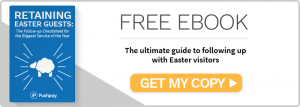How to Create a Post-Easter Email Strategy That Brings Guests Back
It’s likely your church puts more effort into Easter services than any other worship service of the year. You probably prepare for months to make sure you get people inside your doors to experience something unforgettable. Your church should go all out for Easter.
It’s the Super Bowl of the church year.
But if you don’t figure out how to get people to return to your church after Easter, all your efforts won’t matter much. Your goal shouldn’t be to get more people within earshot of your Easter sermon. Instead, you want people engaged in a long-term discipleship process through your church.
Every church should have a multi-pronged approach to following up on worship service attendance, whether it’s during the Easter season or not. Visitation and phone calls can play an important part in that strategy, but email has a unique role, as well.

Email Isn’t Dead
From the moment email burst onto the scene (in full force, at least) in the early 1990s, we’ve heard stories about its upcoming demise. Test messages were supposed to kill it. Social media was supposed to kill it.
But the reports of email’s demise have been greatly exaggerated. Just look at these statistics.
- The number of email users around the world has topped 3.7 billion. (Radicati)
- We send 2,670,100 emails every single second. (internetlivestats.com)
Email isn’t dead. It’s more important than ever. The amount of email noise out there right now is as high as it has ever been. That means those people attending your Easter services have full inboxes. They’re likely not looking for your email. They likely won’t even open your email if you’re not tactful.
So how do you break through the noise?
An Easter Follow-up Email Strategy That Works
Your church needs an inbound marketing strategy built around your Easter services. A systematized email strategy will help your church communicate to Easter guests in a personalized manner and on a pace that draws them into your church community rather than repels them.
Here are four steps to get you started.
1. Get an email automation tool
Automation is the key to a great email marketing campaign. Automating your emails allows you to have pre-written emails sent out based on certain triggers by your Easter guests. With automation, you can have a series of emails already prepared for guests who want them.
Although the features of the high-end automation tools will be worth the money for some large churches, you can also find many cheaper options like MailChimp and Constant Contact that can do the trick if your church has a smaller membership.
Look for an automation tool that is easy-to-use and has strong analytics. The analytic component is particularly important because you need to know what’s working and what’s not. Then you need to be able to adjust your strategy to the realities you’re discovering.
Using email automation tools is a mainstay of excellent church follow up, especially for special events like Easter. Discover how else your church can tell a compelling story that keeps Easter guests coming back. Download the free ebook, Retaining Easter Guests, today.
2. Make sure guests fill out a connection card, preferably on your mobile church app
Obviously, email strategies only work if you can get a hold of email addresses. You probably already do this to some degree in high-impact events like Easter services. You likely use some sort of communication card to get people to provide contact information when they visit your church.
While a communication card is a good start, it tends to be clunky and require extra data processing either for your staff or volunteers. Your mobile app should provide you with a smoother process for capturing email addresses. If you have the Pushpay app, you can simply have guests text your church’s unique keyword to 77977. They’ll receive a link that allows them to download your app. They’ll then be able to fill out your church form.
You can use a variety of standard form creators (such as Survey Monkey, Google Forms, etc.) to create a simple contact form in your Pushpay app. Once your guests fill out the form, the data will be sent to a central location.
3. Define what personas you want to reach
The best way to reach no one with your follow-up emails is to try to reach everyone with them. To write effective emails you need to have a clear picture of the person to whom you’re writing. That starts with personas.
A persona is simply a generalized description of a particular audience you’re trying to reach. Most personas have information about demographics, interests, goals, challenges, etc., of those you’re trying to engage.
You’ll use these personas to not only develop topics but also to better think through the content of your emails.
4. Create emails that nurture an interest in a return trip
Once you’ve decided who you’re writing these emails to, you’ve got to determine what you’re going to tell them. Consider this email campaign to be like a slow conversation. You’re trying to continue the relationship that you started on Easter Sunday.
Again, picture the person to whom you’re writing. Think about what might help that person make a decision about your church. But remember, the email is about your readers, not you.
Consider an email about the felt need you’re engaging in your original Easter sermon or your next sermon series, whether it’s on relationships, joy, parenting, etc. Show your guests you understand the need and how the new series will address it. Make sure your email doesn’t just promote your series but is helpful or encouraging to the reader even if he or she never shows up at your church. It’s not about you.
Consider an email that tells guests about connection opportunities in your church, like small groups or Sunday School classes.
Consider an email that describes children’s ministry opportunities (with the assumption that families are among the personas you’re trying to engage). Address the concerns, needs, or interests your guests might have related to their children attending your church.
Each of these emails should have one, and only one, call to action. Most likely, this will be a link to your website (e.g., a video trailer for your sermon series, your small group finder, etc.). By the way, you’ll need a top-notch, attention-grabbing subject line. It’s probably the most important part of your entire email.
Keep your series of emails to between three and five. Make sure email recipients realize they can opt out of the emails (and make it easy for them to do so). Tell them up front how many emails they’ll get from you and what the topics will be about. At the end of the series, connect them to an ongoing communication of your church (probably an email newsletter, if you have one).
A Broader Inbound Marketing Strategy
A good Easter email strategy is just one part of a broader inbound marketing strategy that can help your church better connect with your community. The digital revolution of the last two decades hasn’t just changed shopping, media consumption, and communications, but it has also revolutionized how people engage with churches.
Discover other best practices growing churches are using to follow up with guests after Easter. Download the free ebook, Retaining Easter Guests, today.
Featured Content
You May Also Like

